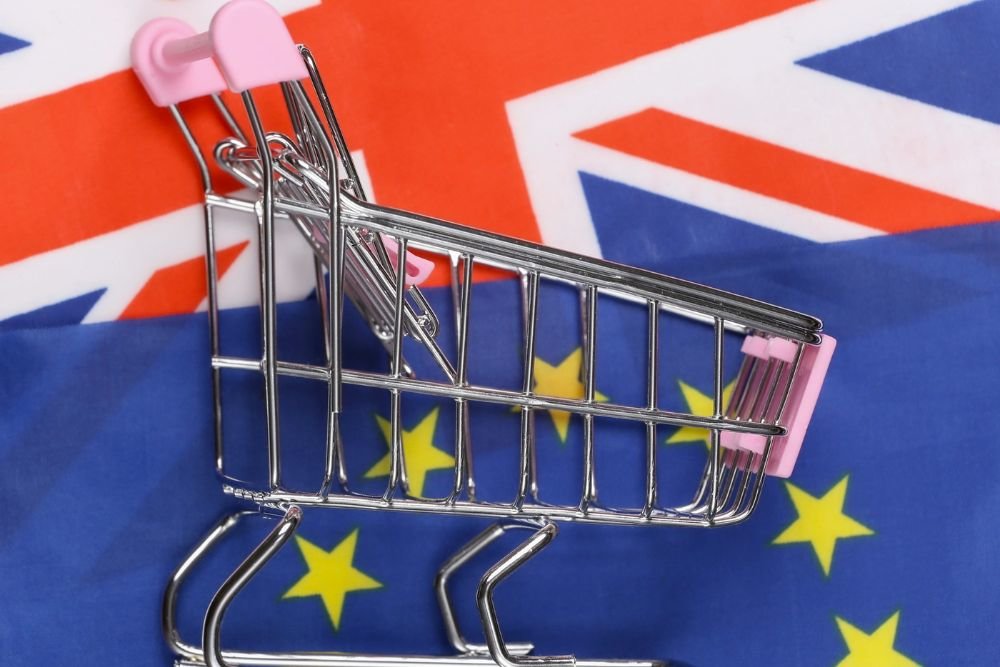How to Open E-Commerce Sales in the U.K. and EU
BlogDecember 14, 2022

The European Union includes 27 of the richest countries in the world, making it a prime target for global e-commerce. In fact, it’s one of the areas identified as having the most growth potential in the $6.2 trillion global e-commerce market in 2023, with 10% average year-over-year growth since the pandemic.
Even post-Brexit, the seven largest markets in Europe represent a nearly $200 billion e-commerce opportunity. The U.K. and Germany are in the lead, followed closely by the Netherlands, France, Spain, Italy, and Portugal. In 2020, Germany had an average annual per-capita expenditure of $73.6 billion, while the U.K. wasn't far behind at $61.4 billion. Additionally, 42% of U.K. online consumers actively shop cross-border.
Companies are finding a lot of benefits in the European market. Its consumers are largely online, with high internet penetration. Consider both the U.K. and Germany, where 95% and 92% of their citizens shop online, respectively. Sweden, as well, sees 96% of the population use e-commerce for everyday purchases. They value American-made products, too. U.K.-based businesses that are able to seamlessly open this revenue stream can triple their sales, and U.S.-based businesses should consider the wealth of opportunities presented by trading with both.
Europe’s e-commerce market is booming, and over a quarter of it is cross-border transactions. This makes it a prime market to target with your e-commerce strategy. However, it’s not as simple as selling in your home country — EU tax law has only strengthened since the global lockdowns. Governments around the world now focus on protecting their local industries, and the EU is no different.
If you’re looking to expand cross-border e-commerce in Europe, our team at Go Global Ecommerce can help you be successful. First, let’s discuss the opportunities.
We refer to it as one place, but the EU, like the U.S., is actually a collection of nuanced markets. Consumers in Italy, for example, still prefer cash-on-delivery (COD) payment options, which are unique to that country’s market. Spain, Germany, and France all have unique markets, as well, and you must understand each respective market’s customs process to avoid having shipments held at the border and delayed.
However, one thing all countries within the EU agree on is data privacy. The EU has strict privacy regulations you must follow when performing cross-border e-commerce in Europe. These restrictions include the General Data Protection Regulation (GDPR), which requires key data protections to be implemented into any website that's accessible in Europe. Also, you must remain compliant with the European Data Protection Board’s adequacy decision and the standard contractual clauses by the European Commission.
There are also shipping regulations to consider, like the Import One Stop Shop (IOSS). An IOSS number is necessary to sell goods under the EU IOSS scheme. Then, there are commercial invoices, delivery times, and CN22 and CN23 customs declarations to file. These required documents ensure you can fulfill deliveries without causing a customer service nightmare.
The EU’s Distance Selling Directive was applied to distance contracts between businesses and consumers. However, this has since been replaced with a new system of duties and taxes, which should be determined upfront. EU tax law applies the value-added tax (VAT) to each stage of the supply chain in which value is added.
Even post-Brexit, the seven largest markets in Europe represent a nearly $200 billion e-commerce opportunity. The U.K. and Germany are in the lead, followed closely by the Netherlands, France, Spain, Italy, and Portugal. In 2020, Germany had an average annual per-capita expenditure of $73.6 billion, while the U.K. wasn't far behind at $61.4 billion. Additionally, 42% of U.K. online consumers actively shop cross-border.
Companies are finding a lot of benefits in the European market. Its consumers are largely online, with high internet penetration. Consider both the U.K. and Germany, where 95% and 92% of their citizens shop online, respectively. Sweden, as well, sees 96% of the population use e-commerce for everyday purchases. They value American-made products, too. U.K.-based businesses that are able to seamlessly open this revenue stream can triple their sales, and U.S.-based businesses should consider the wealth of opportunities presented by trading with both.
Europe’s e-commerce market is booming, and over a quarter of it is cross-border transactions. This makes it a prime market to target with your e-commerce strategy. However, it’s not as simple as selling in your home country — EU tax law has only strengthened since the global lockdowns. Governments around the world now focus on protecting their local industries, and the EU is no different.
If you’re looking to expand cross-border e-commerce in Europe, our team at Go Global Ecommerce can help you be successful. First, let’s discuss the opportunities.
Challenges for Cross-Border Commerce in Europe
The U.K. is a $199.87 billion e-commerce market, with more than 700,000 online retailers. This makes it the largest market in Europe, though Brexit made trade between the U.K. and the rest of the continent difficult. Selling from the U.S. to the U.K. will be different than the EU, and vice versa, due to the various trade negotiations between each respective government.We refer to it as one place, but the EU, like the U.S., is actually a collection of nuanced markets. Consumers in Italy, for example, still prefer cash-on-delivery (COD) payment options, which are unique to that country’s market. Spain, Germany, and France all have unique markets, as well, and you must understand each respective market’s customs process to avoid having shipments held at the border and delayed.
However, one thing all countries within the EU agree on is data privacy. The EU has strict privacy regulations you must follow when performing cross-border e-commerce in Europe. These restrictions include the General Data Protection Regulation (GDPR), which requires key data protections to be implemented into any website that's accessible in Europe. Also, you must remain compliant with the European Data Protection Board’s adequacy decision and the standard contractual clauses by the European Commission.
There are also shipping regulations to consider, like the Import One Stop Shop (IOSS). An IOSS number is necessary to sell goods under the EU IOSS scheme. Then, there are commercial invoices, delivery times, and CN22 and CN23 customs declarations to file. These required documents ensure you can fulfill deliveries without causing a customer service nightmare.
The EU’s Distance Selling Directive was applied to distance contracts between businesses and consumers. However, this has since been replaced with a new system of duties and taxes, which should be determined upfront. EU tax law applies the value-added tax (VAT) to each stage of the supply chain in which value is added.

How Does VAT Work in Europe?
VAT is a far-reaching tax levied at every point in the supply chain, from manufacturing through the point of sale. It’s meant to shift the burden of taxation from income to consumption, so you pay based on how much you buy versus how much you earn. VAT is based on gross margins at the points of initial production, distribution, and sale.
The U.K. has an agreement with the EU through the Trade and Cooperation Agreement that can save you on VAT taxes, as long as you meet specific requirements. So on the one hand, we have favorable tariffs, but on the other, we have higher production costs. These operational expenses should be planned well in advance to ensure compliance while properly calculating overhead expenses.
However, it’s not easy. The pandemic caused governments everywhere to defend their local markets, which can cause problems for out-of-town sellers. If you’re interested in expanding your e-commerce into Europe, contact us at Go Global Ecommere to learn how to properly execute a cross-border e-commerce strategy and find global success.
The U.K. has an agreement with the EU through the Trade and Cooperation Agreement that can save you on VAT taxes, as long as you meet specific requirements. So on the one hand, we have favorable tariffs, but on the other, we have higher production costs. These operational expenses should be planned well in advance to ensure compliance while properly calculating overhead expenses.
Should I Charge VAT to European Customers?
According to EU tax law, you must charge a customer for the VAT tax, with a caveat. Whether you charge it depends on whether they have an EU VAT number. This exempts them from paying at the point of sale, but you can still charge them for VAT on related expenses.Getting Started in the Europe E-Commerce Market
Both the EU and the U.K. are growing markets that continue to favor foreign goods and services. We live in a world that’s more connected than ever, and reaching these markets is possible from anywhere. It can increase revenue while expanding your brand recognition across borders.However, it’s not easy. The pandemic caused governments everywhere to defend their local markets, which can cause problems for out-of-town sellers. If you’re interested in expanding your e-commerce into Europe, contact us at Go Global Ecommere to learn how to properly execute a cross-border e-commerce strategy and find global success.

